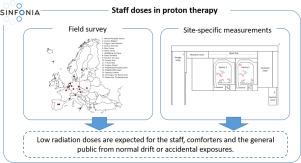质子治疗中的辐射防护:来自sinonia项目中多机构调查和实验测量的见解
IF 2.7
3区 医学
Q1 RADIOLOGY, NUCLEAR MEDICINE & MEDICAL IMAGING
Physica Medica-European Journal of Medical Physics
Pub Date : 2025-08-13
DOI:10.1016/j.ejmp.2025.105049
引用次数: 0
摘要
目的:本研究是欧盟资助的SINFONIA项目的一部分,针对日常PT实践中的辐射防护问题,研究工作人员根据其工作环境和任务可能受到的防护不足或过度。方法:进行了多机构调查,并在PT中心进行了特定中子剂量测量。除了单能量照射,临床治疗脑,胸部(霍奇金淋巴瘤- HL)和骨盆(前列腺),研究了有无范围移位器(RS)。H*(10)使用了Thermo Fisher Scientific WENDI II和Berthold LB6411环境中子监测仪和两台DIAMON中子光谱仪。此外,BTI BD-PND气泡探测器,LANDAUER Neutrak剂量计和Intercast CR-39 +塑料转换器也进行了Hp测试(10)。结果:初步调查结果表明,对工作人员没有相当大的风险,剂量低于1毫西弗/年。此外,在斯坎迪翁设施进行的特定地点测量显示,工作人员控制室的工作人员年剂量为5-10 μSv。另一方面,龙门坑的意外暴露最高可达0.26 μSv/Gy。值得注意的是,H*(10)探测器表现出良好的性能,而Hp(10)剂量计仅捕获治疗室内的剂量,但仍与参考值保持一致。结论:研究结果表明,在现代PT设施中,工作人员的中子暴露风险很小。本文章由计算机程序翻译,如有差异,请以英文原文为准。

Radiation protection in proton therapy: Insights from a multi-institutional survey and experimental measurements within the SINFONIA project
Purpose:
This study, part of the EU-funded SINFONIA project, addresses radiation protection concerns in daily PT practice to study potentially under- or overprotection of staff depending on their working environment and tasks.
Methods:
A multi-institutional survey was carried out, complemented by specific neutron dose measurements at a PT centre. Besides mono-energetic irradiations, clinical treatments for brain, thorax (Hodgkin’s lymphoma — HL) and pelvis (prostate), were investigated with and without range shifter (RS). The Thermo Fisher Scientific WENDI II and Berthold LB6411 ambient neutron monitors and two DIAMON neutron spectrometers were used for H*(10). Furthermore, BTI BD-PND bubble detectors, LANDAUER Neutrak dosimeters and Intercast CR-39 + plastic converters were also tested for Hp(10).
Results:
Initial survey results suggest no considerable risk for staff, with doses registering below 1 mSv/year. Further, site-specific measurements conducted at the Skandion facility, unveil annual staff doses ranging from 5–10 Sv in the staff control room. Accidental exposure scenarios on the other hand could reach up to 0.26 Sv/Gy in the gantry pit. Notably, H*(10) detectors demonstrated good performance, while Hp(10) dosimeters solely captured doses within the treatment room, yet remaining in agreement with reference values.
Conclusion:
Findings suggest a minimal neutron exposure risk for staff members within contemporary PT facilities.
求助全文
通过发布文献求助,成功后即可免费获取论文全文。
去求助
来源期刊
CiteScore
6.80
自引率
14.70%
发文量
493
审稿时长
78 days
期刊介绍:
Physica Medica, European Journal of Medical Physics, publishing with Elsevier from 2007, provides an international forum for research and reviews on the following main topics:
Medical Imaging
Radiation Therapy
Radiation Protection
Measuring Systems and Signal Processing
Education and training in Medical Physics
Professional issues in Medical Physics.

 求助内容:
求助内容: 应助结果提醒方式:
应助结果提醒方式:


